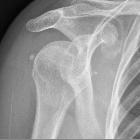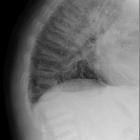tumoröse Kalzinose


















Tumoral calcinosis is a rare familial condition characterized by painless, periarticular masses. The term should be strictly used to refer to a disease caused by a hereditary metabolic dysfunction of phosphate regulation associated with massive periarticular calcinosis and should not be used to refer to soft-tissue calcification in general.
Epidemiology
The condition predominantly affects young black patients with an equal M:F.
Clinical presentation
Most patients present with lumps adjacent to joints. They are usually painless, but some patients describe pain and tenderness. Involvement of large joints is typical, although the knee is rarely involved. The underlying bone is normal.
Pathology
One-third of cases are familial (autosomal dominant) with abnormal FGF23 protein , and serum calcium is normal (some sources state that hyperphosphatemia is common).
It is characterized by large amorphous calcific densities that surround joints. These are separated into lobules by fibrous septa and may demonstrate fluid/calcium levels (milk of calcium / hydroxyapatite crystals in suspension).
Location
The most common locations are (in descending order of frequency) :
- hip
- elbow
- shoulder
- foot
- wrist
Radiographic features
Plain radiograph
Tumoral calcinosis has a typical appearance on plain radiographs with amorphous and multilobulated ("cloud-like") calcification located in a periarticular distribution.
CT
- CT better delineates the calcific mass
- there is no erosion or osseous destruction by the adjacent soft-tissue masses which is another distinguishing finding of tumoral calcinosis from other pathologies
- it may show cystic appearance with multiple fluid-calcium levels caused by calcium layering (sedimentation sign)
MRI
MR imaging with T2-weighted sequences shows inhomogeneous high-signal intensity, even though there is a significant amount of calcification. T1-weighted sequences usually show inhomogeneous lesions with low signal intensity.
Differential diagnosis
General imaging differential considerations include:
- hyperparathyroidism: most frequently in chronic renal failure
- calcium pyrophosphate deposition disease (CPPD)
- myositis ossificans
- calcinosis circumscripta
- calcinosis universalis
- milk-alkali syndrome
- hypervitaminosis D
- calcinosis of chronic renal failure
- calcific tendonitis
- synovial osteochondromatosis
- synovial sarcoma
- osteosarcoma
- calcific myonecrosis
- tophaceous gout
Siehe auch:
- synoviale Osteochondromatose
- Osteosarkom
- Gicht
- Myositis ossificans
- Tendinitis calcarea
- Weichteilverkalkungen
- primärer Hyperparathyreoidismus
- periartikuläre Verkalkungen
- Synovialsarkom
- Hydroxylapatit-Ablagerungserkrankung
- Chondrokalzinose
- calcinosis circumscripta
- Kalziumpyrophosphat-Ablagerungskrankheit
- Kristallarthropathie
- chronische Niereninsuffizienz
- Burnett-Syndrom
- dystrophic soft-tissue calcification
- Hypervitaminose D
- Calcinosis cutis universalis
- verkalkende Myonekrose
- tumoral calcinosis of subdeltoid bursa
- verkalktes Hämatom
und weiter:

 Assoziationen und Differentialdiagnosen zu tumoröse Kalzinose:
Assoziationen und Differentialdiagnosen zu tumoröse Kalzinose:
















